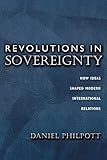Revolutions in Sovereignty : How Ideas Shaped Modern International Relations / Daniel Philpott.
Material type: TextSeries: Princeton Studies in International History and Politics ; 122Publisher: Princeton, NJ : Princeton University Press, [2010]Copyright date: ©2001Edition: Core TextbookDescription: 1 online resource (352 p.) : 5 line illus., 7 tablesContent type:
TextSeries: Princeton Studies in International History and Politics ; 122Publisher: Princeton, NJ : Princeton University Press, [2010]Copyright date: ©2001Edition: Core TextbookDescription: 1 online resource (352 p.) : 5 line illus., 7 tablesContent type: - 9780691057477
- 9781400824236
- 320.1/5 21
- JZ4034 .P48 2001eb
- online - DeGruyter
- Issued also in print.
| Item type | Current library | Call number | URL | Status | Notes | Barcode | |
|---|---|---|---|---|---|---|---|
 eBook
eBook
|
Biblioteca "Angelicum" Pont. Univ. S.Tommaso d'Aquino Nuvola online | online - DeGruyter (Browse shelf(Opens below)) | Online access | Not for loan (Accesso limitato) | Accesso per gli utenti autorizzati / Access for authorized users | (dgr)9781400824236 |
Browsing Biblioteca "Angelicum" Pont. Univ. S.Tommaso d'Aquino shelves, Shelving location: Nuvola online Close shelf browser (Hides shelf browser)

|

|

|

|

|

|

|
||
| online - DeGruyter The Limits of Convergence : Globalization and Organizational Change in Argentina, South Korea, and Spain / | online - DeGruyter Liberalism Beyond Justice : Citizens, Society, and the Boundaries of Political Theory / | online - DeGruyter Diplomacy of Conscience : Amnesty International and Changing Human Rights Norms / | online - DeGruyter Revolutions in Sovereignty : How Ideas Shaped Modern International Relations / | online - DeGruyter With the Stroke of a Pen : Executive Orders and Presidential Power / | online - DeGruyter Disjointed Pluralism : Institutional Innovation and the Development of the U.S. Congress / | online - DeGruyter Learning and Expectations in Macroeconomics / |
Frontmatter -- CONTENTS -- TABLES AND FIGURES -- PREFACE -- PART ONE: REVOLUTIONS IN SOVEREIGNTY -- PART TWO: THE FOUNDING OF THE SOVEREIGN STATES SYSTEM AT WESTPHALIA -- PART THREE: THE REVOLUTION OF COLONIAL INDEPENDENCE: THE GLOBAL EXPANSION OF WESTPHALIA -- PART FOUR: THE REVOLUTIONS CONSIDERED TOGETHER -- NOTES -- BIBLIOGRAPHY -- INDEX
restricted access online access with authorization star
http://purl.org/coar/access_right/c_16ec
How did the world come to be organized into sovereign states? Daniel Philpott argues that two historical revolutions in ideas are responsible. First, the Protestant Reformation ended medieval Christendom and brought a system of sovereign states in Europe, culminating at the Peace of Westphalia in 1648. Second, ideas of equality and colonial nationalism brought a sweeping end to colonial empires around 1960, spreading the sovereign states system to the rest of the globe. In both cases, revolutions in ideas about legitimate political authority profoundly altered the "constitution" that establishes basic authority in the international system. Ideas exercised influence first by shaping popular identities, then by exercising social power upon the elites who could bring about new international constitutions. Swaths of early modern Europeans, for instance, arrived at Protestant beliefs, then fought against the temporal powers of the Church on behalf of the sovereignty of secular princes, who could overthrow the formidable remains of a unified medieval Christendom. In the second revolution, colonial nationalists, domestic opponents of empire, and rival superpowers pressured European cabinets to relinquish their colonies in the name of equality and nationalism, resulting in a global system of sovereign states. Bringing new theoretical and historical depth to the study of international relations, Philpott demonstrates that while shifts in military, economic, and other forms of material power cannot be overlooked, only ideas can explain how the world came to be organized into a system of sovereign states.
Issued also in print.
Mode of access: Internet via World Wide Web.
In English.
Description based on online resource; title from PDF title page (publisher's Web site, viewed 30. Aug 2021)


